DNA and Genealogy Records Updates at Ancestry
Ancestry dominates this week’s genealogy news with a new update for AncestryDNA genetic communities! Also new from Ancestry this week are big updates to collections for England and Canada. Featured: AncestryDNA NewsAnnounced on Tuesday, February 19:...Big Updates to Find A Grave Records at Ancestry.com
If you’re looking for cemetery records, you’re in luck! This week there have been massive updates to Find A Grave’s global databases at Ancestry.com. But why search Find A Grave at Ancestry.com? We can think of 3 good reasons.
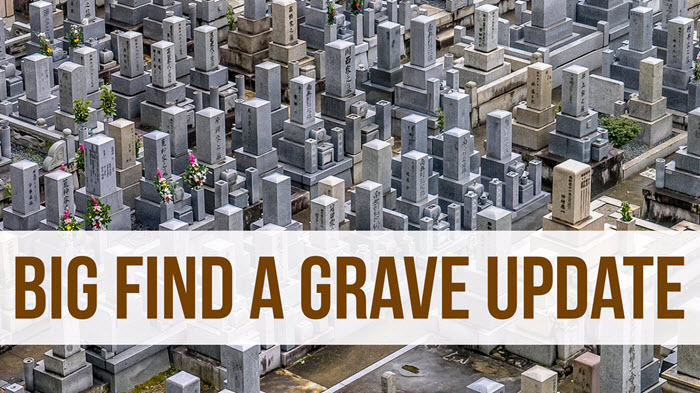
Find A Grave at Ancestry.com: Updated Collections
Did you know you can use Google Earth to find cemeteries? Click here to learn how.
The following Find A Grave collections have all been updated to Ancestry.com, where they can be linked directly to your tree:
- Global, Index for Burials at Sea and other Select Burial Locations, 1300s-Current
- UK & Ireland 1300s-Current
- Canada 1600s-Current
- Australia & New Zealand 1800s-Current
- Germany 1600s-Current
- United States 1600s-Current
- Italy 1800s-Current
- Norway 1800s-Current
- Sweden 1800s-Current
- Mexico 1800s-Current
- Brazil 1800s-Current
You’ll also find these records updated at FamilySearch.com as well.
If there’s a specific grave you’re looking for, ask Find a Grave to help! Click here to learn how to submit a photo request to both Find a Grave and Billion Graves.
Why Use Find A Grave at Ancestry.com?
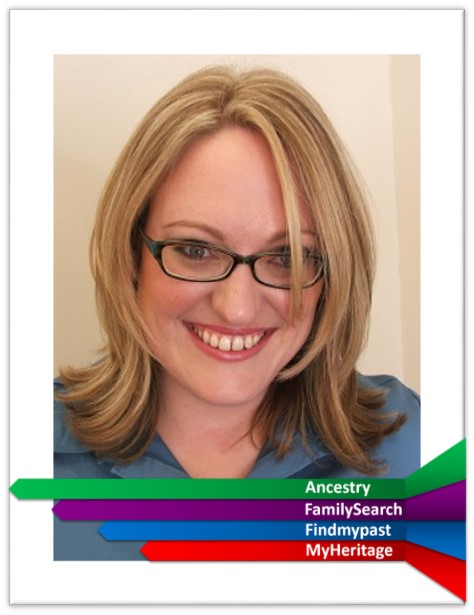
Sunny Morton, Genealogy Giants Guru
Find A Grave is a free website with crowd-sourced tombstone images and transcriptions from cemeteries all over the world. Last we checked, they boast 162 million grave records! Their catalog of cemeteries tops 400,000, spread out over 200 different countries, and they have at least a partial listing of graves for well over half of these (over 250,000).
So why would you go to Ancestry.com to search records that are already free at Find A Grave? Genealogy Gems Contributing Editor Sunny Morton, our resident expert on the giant genealogy websites, says:
“If you’re already an Ancestry.com subscriber, searching Find A Grave from within Ancestry.com may be a good choice for these three reasons:
1. One-stop searching. You’re already searching in Ancestry.com: you don’t need to remember to switch over to search Find A Grave separately for each ancestor.
2. Ancestry.com’s search tool. Find A Grave has a nice but basic search tool. It’s pickier about the search results it returns: does the spelling match? And is a potential result in the exact place you requested? (If you search a specific county, Find A Grave will only return results from that county–not in an adjacent county, across the state line, or even across the country where an ancestor may have been interred.) Lacey has a great example below.
From Lacey: Here’s a search of my 3X great grandfather at Find A Grave:

Unfortunately, no results:
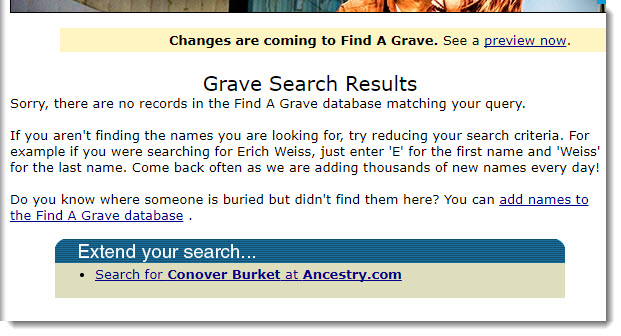
I then hopped over to Ancestry, went to the card catalog, and searched the U.S. Find A Grave Index:
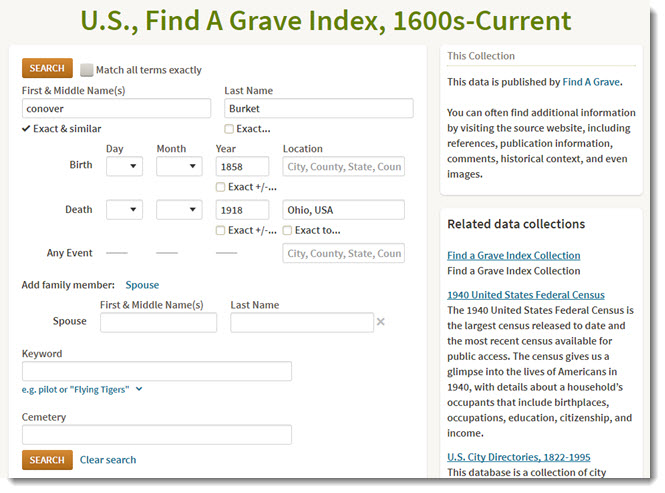
Turns out there was an extra “t” on his surname (see results below). I didn’t search on a partial name because I’ve never come across a different spelling of his before, and I certainly didn’t expect to see one on his tombstone! But sure enough, the name is not spelled as it had been throughout his life. It’s awfully nice that Ancestry could find it:
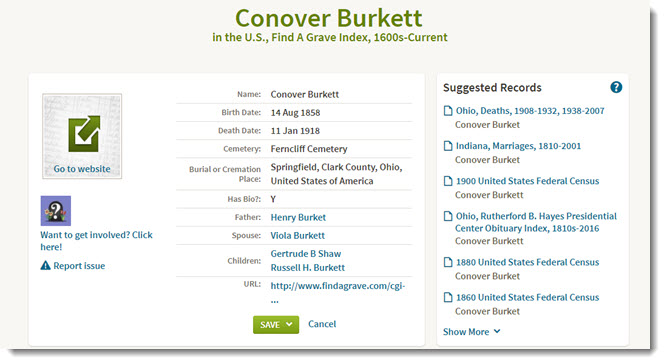
Ancestry.com is much more forgiving and flexible about spelling and places. It will return search result possibilities that don’t have to match exactly. As you can see from the screenshots above, Ancestry offers more fields to enter, including relatives’ names (and people are often buried with relatives), a more detailed place field, and keywords.
3. Tree-building ease. If you build your tree on Ancestry.com, it’s easy to attach Find A Grave search results to your ancestor’s tree profiles. If you search separately at Find A Grave, you have to create a separate source citation to attach to your tree.” (Note: hopefully, if you’re building your tree on Ancestry.com, you’re syncing it to your own software. RootsMagic and Family Tree Maker will both sync to your Ancestry tree–click here to see why Lisa Louise Cooke prefers RootsMagic.)
More Cemetery Resources
 Get detailed step-by-steps for using Find A Grave and Billion Graves, plus guides for understanding tombstone epitaphs and symbol meanings in this brand new book: The Family Tree Cemetery Field Guide. Discover tools for locating tombstones, tips for traipsing through cemeteries, an at-a-glance guide to frequently used gravestone icons, and practical strategies for on-the-ground research.Use coupon code GEMS17 for an extra 10% off! *Coupon valid through 12/31/17.
Get detailed step-by-steps for using Find A Grave and Billion Graves, plus guides for understanding tombstone epitaphs and symbol meanings in this brand new book: The Family Tree Cemetery Field Guide. Discover tools for locating tombstones, tips for traipsing through cemeteries, an at-a-glance guide to frequently used gravestone icons, and practical strategies for on-the-ground research.Use coupon code GEMS17 for an extra 10% off! *Coupon valid through 12/31/17.
https://lisalouisecooke.com/2016/07/cemetery-records/
Disclosure: This post contains affiliate links and Genealogy Gems will be compensated if you make a purchase after clicking on these links (at no additional cost to you). Thank you for supporting Genealogy Gems!
Exploring Family Health History: DNA and Your Health
Exploring our family health history is just another reason to look forward to the future of DNA testing. As science advances and we find out more regarding the specific genetic code responsible for various nefarious outcomes in our health, we learn there is more in play than just our genetics.
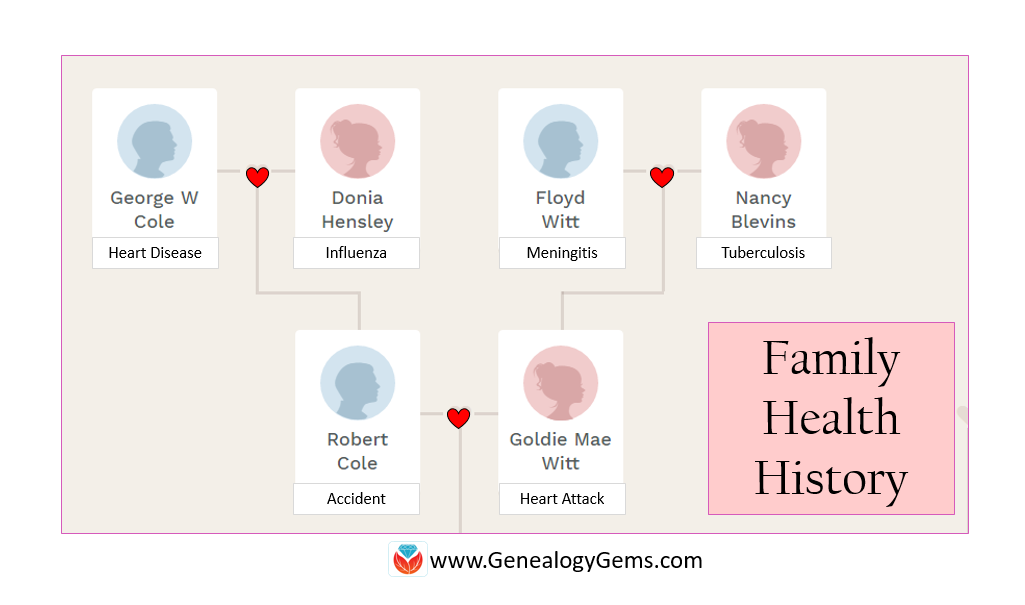
I recently read an article in the Wall Street Journal about a family who has been plagued with sudden deaths, ten in recent generations. Without warning, their hearts were stopping and no one knew why. That is until Daniel Wiggins died suddenly at the age of 29 and his family sought out a molecular autopsy. Becoming more accessible to researchers as the cost of running these tests drop, molecular autopsies allow a scientific team to analyze the DNA of the deceased, looking for genetic clues to the cause of death. In this case, the genetic sleuthing was able to turn up the perpetrator: a mutation that alters the electrical signals in the heart, causing it to stop. [Read more about this here.]
While this case was clear-cut and the gene was acting seemingly alone without an accomplice, researchers of this disorder say it only happens in 20% of cases. Which means, this devious genetic criminal has other methods we still haven’t tracked.
But for Daniel’s family, they can pursue genetic testing to determine if this specific culprit is lurking in their own genes. If found, they can take precautionary measures, like having a defibrillator installed.
Doing Our Part
Similarly, a family from Pennsylvania used their family reunion as a format for gathering family history and genetic information in order to arm its members with an action plan against a plague of cancer that is sweeping through their family. [See an article on this family here.]
Several members of the Shaffer-Peterson family have discovered a genetic test can alert them to possible pancreatic or skin cancer. Again, a gene affecting a very small number of melanoma patients was identified as the perpetrator of the Shaffer-Peterson family and has been given a 67% crime rate. This means that the chance of developing cancer if you have this particular gene is elevated by 67%.
Thankfully, melanoma is a particularly curable kind of cancer when caught early. This family has done their part in informing the family as a whole. And, they now have a sort of insurance plan that may protect the lives of their loved ones.
For both the Shaffer-Petersons and the family of Daniel Wiggins, genetic tests produce actionable results to those testing positive. There is something they can do to positively impact their health once they are aware of the presence or absence of these genes in themselves.
Environment or DNA?
Not all diseases or conditions can be attributed to our DNA. This past fall, after talking with my mother about kids and schedules, she added almost in passing, “Oh, by the way, they found another spot on my back, I am going to have it removed next week.” This is the third melanoma spot she has had removed in the past 5 years.
While my mom’s melanoma is less likely to be the result of a genetic abnormality and more likely linked to spending hours lifeguarding at the local pool, the fact she had melanoma was the sole reason I went to the dermatologist. My spot wasn’t cancer. I was just getting older. But, I am glad I went and I feel like knowing my health history has made me more aware of the measures I can take to improve it.
Tracking Your Family Health History

Diahan offers Genealogy Gems fans a discount on access to her series of videos on understanding DNA testing for genealogy. Click here to learn more.
For most people, molecular autopsies and DNA health tests are not easily available. Not yet. For those that are, there are hundreds of questions surrounding the kinds of genetic tests and the implications for both health and legal issues.
One thing is certain. In these cases, the common thread is family history. We need to know not only the dates and places of our ancestors lives and deaths, but also the stories behind them. Whenever possible, we need to track our health history, so we can identify any trends that our DNA might be trying to tell us.
If you want to start tracking your own health history there are plenty of free and subscription online tools to get you started. In particular, TapGenes was the winner of the 2016 Innovator Showdown at RootsTech. This online and app tool is designed specifically for your family health management.
You can also create your own alternate family tree. In this unique way, you can visually look at age-at-death, diseases, or other factors pertaining to your health. Read our article titled, “How and Why to Create an Alternate Family Tree.”
Learn More About Genetics and Genealogy
 This special bundle features the 3 new advanced DNA guides by Diahan Southard!
This special bundle features the 3 new advanced DNA guides by Diahan Southard!
Digital download also available.
Gedmatch: A Next Step for Your Autosomal DNA Test
Gedmatch is a third‐party tool for use by genetic genealogists seeking to advance their knowledge of their autosomal DNA test. This guide will navigate through the myriad of options and point out only the best tools for your genetic genealogy research.
Organzing Your DNA Matches
With over 2.5 million people in the possession of a DNA test, and most with match lists in the thousands, many are wondering how to keep track of all this data and apply it to their family history. This guide provides the foundation for managing DNA matches and correspondence, and for working with forms, spreadsheets, and 3rd party tools.
Next Steps: Working With Your Autosomal DNA Matches
This guide outlines what to do next to maximize the power of DNA testing in genealogy. With this guide in hand, genealogists will be prepared to take their DNA testing experience to the next level and make new discoveries about their ancestors and heritage.
